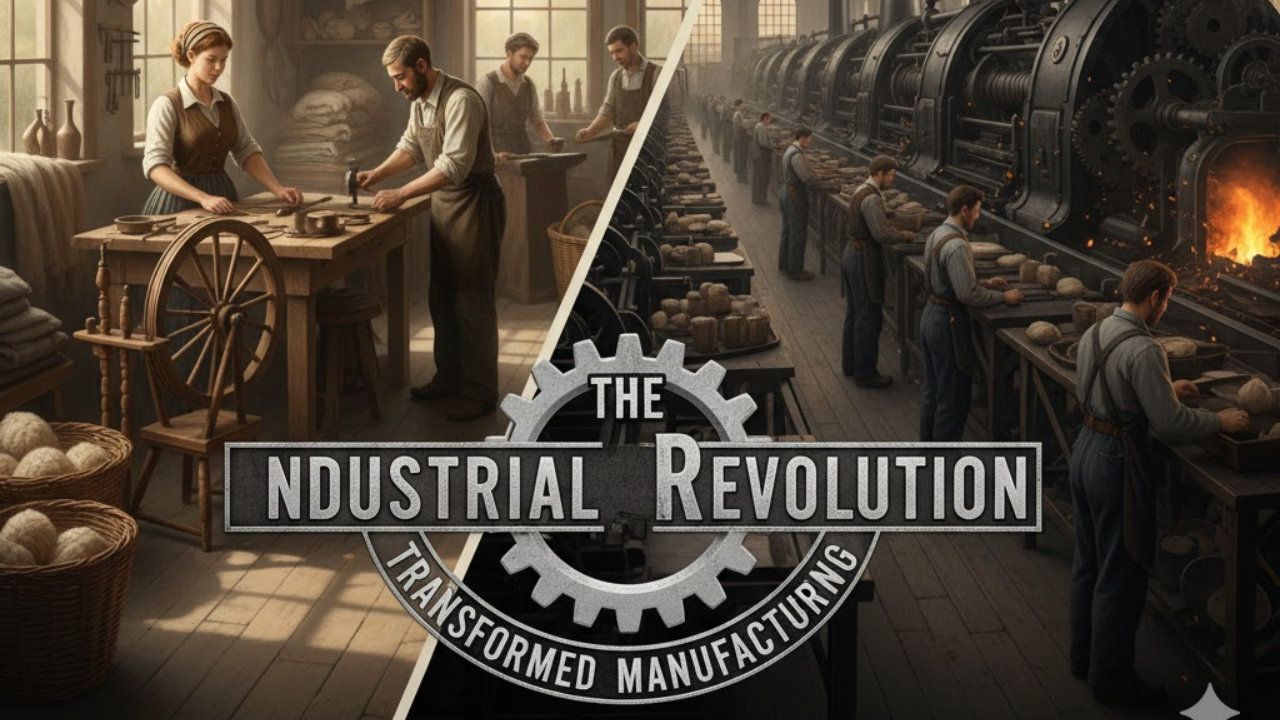
Post by : Meena Rani
In the late 18th century, a transformation quietly began in Britain: small workshops and artisan hands gave way to steam-powered machines and factory walls. This era — known as the Industrial Revolution — didn’t just alter how goods were made. It altered how societies functioned, how cities grew, and how human potential scaled beyond centuries of agrarian limits.
Before industrialization, manufacturing was largely a domestic or cottage endeavor: skilled artisans working in homes or small workshops, often under a “putting-out” system where merchants supplied materials and collected finished goods. Then came mechanical breakthroughs: the spinning jenny, water frame, power loom, and later steam engines. Suddenly, production moved beyond the limitation of hands and muscle to power, gear, and velocity. Factories became the new centers of productivity, clustered near coal, water, and transport routes.
As machinery spread, output soared. Products that once required weeks of hand labor could now be produced in hours, at fractions of cost. Factories embraced division of labor: workers specialized in small tasks on long production lines. Economies of scale made bulk manufacturing profitable. The result: goods became more affordable, consumption widened beyond elites, and demand fueled growth.
Manufacturing pulled populations off farms and into cities. Industrial towns mushroomed, often overnight, filled with workers seeking factory wages. Working conditions were harsh: long hours, child labor, safety risks, low pay. Families, gender roles, and social structures had to adapt. Labor movements, unions, and political reform would eventually challenge factory excesses.
The first wave was steam and water power; machines turned energy into motion. Next came the Second Industrial Revolution, in which electricity, chemical processes, and internal-combustion engines further redefined manufacturing. Factories became more flexible, lines more complex, and power distribution more decentralized.
The Industrial Revolution set the stage for each subsequent wave of manufacturing change. Today, we talk of Industry 4.0 — smart factories, cyber-physical systems, industrial IoT, advanced robotics, and AI integration. The DNA of mass production, division of labor, and mechanized processes still resides in modern manufacturing, but now complemented by sensors, connectivity, and data intelligence.
It democratized access to commodities — textiles, tools, appliances — making them affordable to many
It enabled global trade and connected supply chains across continents
It rewrote labor value: machines displaced some tasks but created others
It reshaped power: states, capital, and industry became intertwined
It set the foundation for our energy, transportation, and technology systems
This article is based on historical research and publicly available sources as of 2025. It is intended for educational and analytic purposes only and does not promote any political or economic agenda. Readers seeking deeper technical detail should consult academic sources and industrial histories.
Industrial Revolution, mechanization, factory system, mass production, Industry 4.0, manufacturing history, technological change, labor migration, smart factories, industrial legacy










Advances in Aerospace Technology and Commercial Aviation Recovery
Insights into breakthrough aerospace technologies and commercial aviation’s recovery amid 2025 chall

Defense Modernization and Strategic Spending Trends
Explore key trends in global defense modernization and strategic military spending shaping 2025 secu

Tens of Thousands Protest in Serbia on Anniversary of Deadly Roof Collapse
Tens of thousands in Novi Sad mark a year since a deadly station roof collapse that killed 16, prote

Canada PM Carney Apologizes to Trump Over Controversial Reagan Anti-Tariff Ad
Canadian PM Mark Carney apologized to President Trump over an Ontario anti-tariff ad quoting Reagan,

The ad that stirred a hornets nest, and made Canadian PM Carney say sorry to Trump
Canadian PM Mark Carney apologizes to US President Trump after a tariff-related ad causes diplomatic

Bengaluru-Mumbai Superfast Train Approved After 30-Year Wait
Railways approves new superfast train connecting Bengaluru and Mumbai, ending a 30-year demand, easi